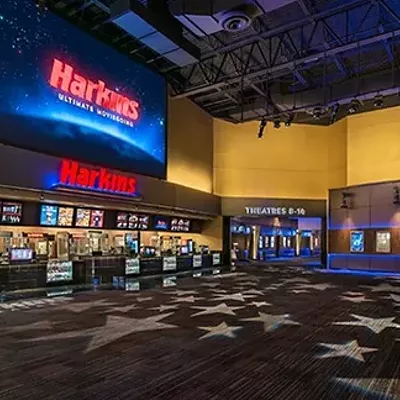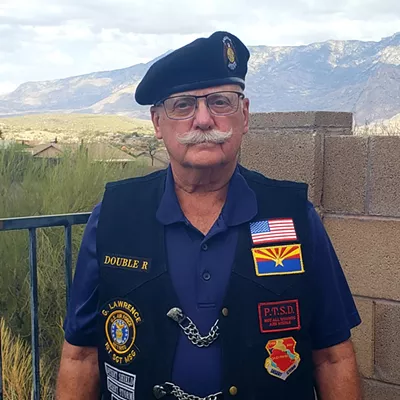Now the project is facing a change in direction not matched since Roy Riegels' wrong-way run in the 1929 Rose Bowl.
The concept of the roadway was originally approved in 1982. Seven years later, rising costs and intense community opposition drove the Arizona Department of Transportation out of the planning process for the last mile. The City of Tucson then assumed responsibility for completing the project from the intersection of Barraza/Aviation at Broadway Boulevard west of the intersection of St. Mary's Road and Interstate 10 -- where, of course, the state Department of Transportation is now eliminating the on- and off-ramps to I-10, leaving Aviation Parkway connected only to a frontage road.
To create this very expensive one-mile roadway (which, incidentally, will include five stoplights), the city outlined a seven-phase, 25-year program moving from east to west. According to city engineers, the first two phases had to be built at Fourth and Sixth avenues to relieve downtown traffic congestion expected by 2002.
Now, however, those plans may be changed dramatically to have phases two through seven go from west to east. The rationale behind this possible switch is due not to traffic flow, but to water.
Initial plans for the last mile project called for installing a new drainage system to replace the existing 70-year-old box culvert which runs parallel to the railroad tracks through downtown. Two options for this estimated $17 million drainage work were considered. Both alternatives assumed that it would be done to facilitate the east-to-west construction of the last mile of roadway.
Now that's changing. The city is in the process of beginning a nine-month study, costing from $500,000 to $700,000, to re-evaluate its downtown drainage options. Armando Monteverde, project manager for the city's Department of Transportation, suspects the consultant will recommend almost completely flipping the phasing plan.
Monteverde's explanation for this possible shift, after city officials had told the public for many years of the opposite phasing strategy: "It makes more sense from an engineering standpoint," because the new culvert should be built going upstream. However, he emphasizes that a final decision will have to weigh both drainage and traffic factors before it is made.
John Kromko, a longtime opponent of the project, sees things differently. He suggests that by proposing to build the bookend parts of the project first, the city is simply maneuvering to insure that the entire roadway must eventually be completed, whether it is needed or not.
"They are trying to lock in a bad situation by doing this," Kromko says, "and that is especially evil because they know people won't use the road. Even though the existing parkway isn't being heavily used, by using this strategy the city wants to lock in the entire last mile."
Wherever and whenever it goes in, the size of the new drainage pipe for the last mile of Barraza/Aviation will be based on the assumption that the proposed Arroyo Chico detention basin will be built. If the controversial basin isn't constructed, will downtown's underpasses and streets continue to be subjected to flooding every monsoon season?
One city engineer's reaction: "I don't want to think about it."
Jim Glock, deputy director of the city's Transportation Department, is more diplomatic. There will be a "downtown flooding challenge," Glock says, and the city will "need to revisit the issue of downtown flooding problems" if the $17 million basin isn't implemented.
The construction phase switcheroo of the last mile isn't the only change which is affecting planning for the downtown portion of the parkway. Cost estimates continue to rise, which will have an impact on what actually gets built. As plans for the project's first phase near completion, the city has secured $10.4 million in restricted gas-tax dollars to build a new underpass at Fourth Avenue for automobiles and trolley tracks, while also reconstructing the existing 1916 underpass for pedestrian use.
The project is estimated to cost $14 million, meaning substantial cuts will have to be made. Among the potential casualties: a pedestrian bridge, $250,000 worth of artwork, and a cutback in the amount of new track put in for the trolley. But even if all of these cuts are made, the project will still be $1 million over budget.
The scheduled start of the construction, which is expected to last 12 to 18 months, is also being delayed until at least late next year. Downtown's Greyhound bus station must first be moved to a new building at Sixth and Toole avenues, and there's contaminated soil to clean. The City Hall Annex on Pennington Street is scheduled to be demolished in conjunction with the project. About the only thing related to the last mile of Barraza/Aviation that has kept rolling along over the years is a series of lucrative consulting contracts totaling in the millions of dollars.
The Fourth Avenue work also isn't the only component of the downtown parkway experiencing substantial cost increases. The plans to construct a Diamondback-shaped bikeway over the Broadway-Euclid interchange were delayed until this summer when the low bid on the $1.2 million project was $300,000 too high.
Despite the delays and climbing costs, city engineers insist the last mile project must be built, despite the fact that traffic on the existing Barraza/Aviation Parkway near Broadway is very low. Only about 11,500 cars use the road each day, which is about the volume typically found on a two-lane collector street.
"The last mile has been the Tucson Transportation Department's dream for a long time, whether it makes sense or not," Kromko says. "There is compulsive behavior by the entire department to jam this project down our throats. Even though the road goes nowhere, they want to build it anyway."









